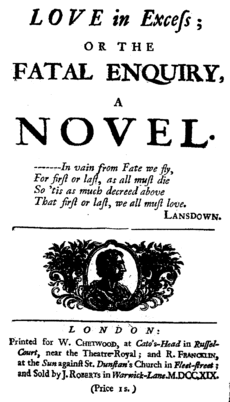Love in Excess; or, The Fatal Enquiry

Love in Excess (1719–1720) is Eliza Haywood's best known novel. It details the amorous escapades of Count D'Elmont, a rake who becomes reformed over the course of the novel. Love in Excess was a huge bestseller in its time, going through multiple reissues in the four years following its initial publication.[1] It was once compared in terms of book sales with Gulliver's Travels and Robinson Crusoe.[2] This information was revealed to be incorrect, the believed success of this novel is much more marginal, selling only about 6000 copies over 23 years.[3]
Summary
The first part details the competition between Alovisa and Amena, two upper-class young women of disparate wealth, for D'Elmont's attentions. The narrator specifically mentioned the "custom which forbids women to make a declaration of their thoughts." That women were not permitted to express their affections or choice until a suitor formally proposed marriage is important to both the plot and the theme of the novel.[4] Alovisa writes an unsigned letter to D'Elmont in hopes of eliciting a definite amorous response from him, which inadvertently leads D'Elmont to court Amena. Amena's father refuses to allow his daughter to continue meeting with D'Elmont without a proposal of marriage, which forces the pair to meet via subterfuge. With the help of Anaret, Amena's woman servant, two attempts for the pair to meet are made, the second of which sees Amena and D'Elmont alone in the Tuileries at night. The two are compromised by the intervention of Alovisa's servant, Charlo, who awakens Amena's household. Amena is eventually conducted by D'Elmont to Alovisa's residence. Alovisa feigns desire to help the pair by allowing them to meet in her apartment; however, Alovisa agrees with Amena's father (unbeknownst to Amena) to help ship Amena off to a convent in the countryside. Amena discovers Alovisa's designs for D'Elmont's affections when D'Elmont mistakenly slips her one of Alovisa's letters, which results in her begging to be sent away as soon as possible. D'Elmont, in the meanwhile, has left to receive his brother, Chevalier Brillian. During the course of their conversation, it is revealed that the Chevalier has fallen in love with Alovisa's sister Ansellina (who resides in Amien). The first part concludes with a mutual decision by Brillian and D'Elmont to marry the sister-pair Alovisa and Ansellina with love, status, and wealth as motivations for the respective matches.
Part the Second deals with D'Elmont's falling in "true" love with Melliora, a girl entrusted in his care. D'Elmont ends up nearly raping the loving but resisting Melliora; meanwhile, D'Elmont's friend, Baron D'Espernay, falls in love with D'Elmont's wife Alovisa. A climax scene leads to the death of the Baron and Alovisa and D'Elmont's self-exile.
D'Elmont ends up in Italy in Part the Third, endlessly yearning for Melliora - who in the meantime has been kidnapped from the convent to which she was sent after Part the Second. In Italy, D'Elmont happens to meet Frankville, Melliora's brother. D'Elmont helps Frankville flee Italy with his forbidden love Camilla; the two women in Italy who have fallen in love with D'Elmont (Ciamara, the lusty "bad" woman; and Violetta, the chaste "good" woman) both end up dead. The survivors - D'Elmont and Melliora; Frankville and Camilla; Melliora's kidnapper and Charlotta, a girl he loved before Melliora - all marry.
Major themes
A work of amatory fiction, Love in Excess offers many models of female desire, and ultimately articulates the early-18th century "cultural shift toward a compassionate model of marriage."[4] The conflict of public behavior, expectations, and decorum vs. individual and private longings and desires. The novel also directly examines and illustrates the ways in which women and female desire are silenced by societal conventions.[4]
References
- ↑ David Scott Kastan (2006). The Oxford encyclopedia of British literature. Oxford University Press. p. 10. ISBN 978-0-19-516921-8. Retrieved 17 March 2012.
- ↑ McBurney, William H. "Mrs. Penelope Aubin and the Early Eighteenth-Century English Novel." Huntington Library Quarterly 20 (1957)
- ↑ Spedding, Patrick (2004). A bibliography of Eliza Haywood. London: pickering and chatto. pp. 88–90.
- 1 2 3 Love in Excess, ed. David Oakleaf, 2000, Broadview Press Ltd., Ontario, Canada